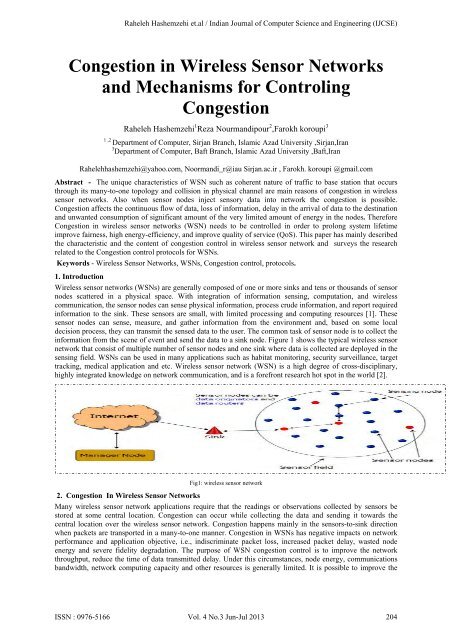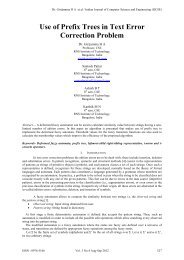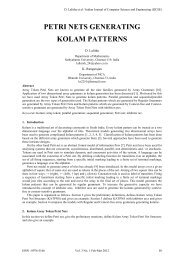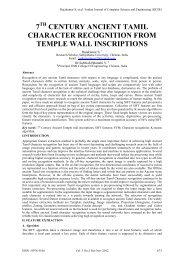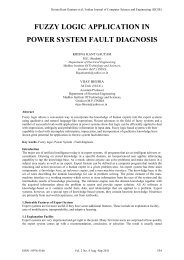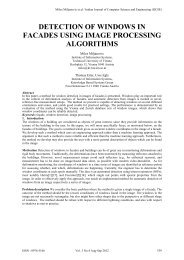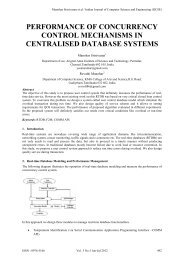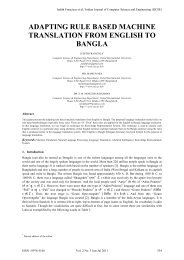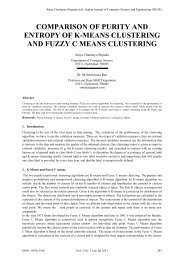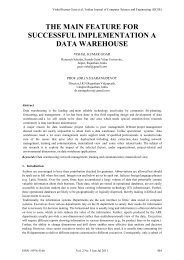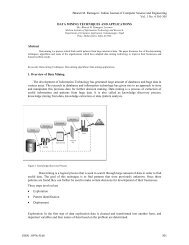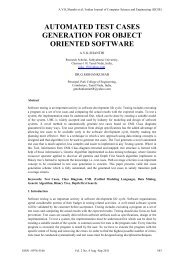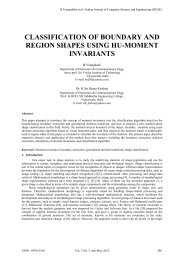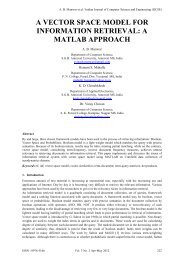Congestion in Wireless Sensor Networks and Mechanisms for ...
Congestion in Wireless Sensor Networks and Mechanisms for ...
Congestion in Wireless Sensor Networks and Mechanisms for ...
You also want an ePaper? Increase the reach of your titles
YUMPU automatically turns print PDFs into web optimized ePapers that Google loves.
Raheleh Hashemzehi et.al / Indian Journal of Computer Science <strong>and</strong> Eng<strong>in</strong>eer<strong>in</strong>g (IJCSE)<br />
<strong>Congestion</strong> <strong>in</strong> <strong>Wireless</strong> <strong>Sensor</strong> <strong>Networks</strong><br />
<strong>and</strong> <strong>Mechanisms</strong> <strong>for</strong> Control<strong>in</strong>g<br />
<strong>Congestion</strong><br />
Raheleh Hashemzehi 1 Reza Nourm<strong>and</strong>ipour 2 ,Farokh koroupi 3<br />
1 ,2<br />
Department of Computer, Sirjan Branch, Islamic Azad University ,Sirjan,Iran<br />
3 Department of Computer, Baft Branch, Islamic Azad University ,Baft,Iran<br />
Rahelehhashemzehi@yahoo.com, Noorm<strong>and</strong>i_r@iau Sirjan.ac.ir , Farokh. koroupi @gmail.com<br />
Abstract - The unique characteristics of WSN such as coherent nature of traffic to base station that occurs<br />
through its many-to-one topology <strong>and</strong> collision <strong>in</strong> physical channel are ma<strong>in</strong> reasons of congestion <strong>in</strong> wireless<br />
sensor networks. Also when sensor nodes <strong>in</strong>ject sensory data <strong>in</strong>to network the congestion is possible.<br />
<strong>Congestion</strong> affects the cont<strong>in</strong>uous flow of data, loss of <strong>in</strong><strong>for</strong>mation, delay <strong>in</strong> the arrival of data to the dest<strong>in</strong>ation<br />
<strong>and</strong> unwanted consumption of significant amount of the very limited amount of energy <strong>in</strong> the nodes. There<strong>for</strong>e<br />
<strong>Congestion</strong> <strong>in</strong> wireless sensor networks (WSN) needs to be controlled <strong>in</strong> order to prolong system lifetime<br />
improve fairness, high energy-efficiency, <strong>and</strong> improve quality of service (QoS). This paper has ma<strong>in</strong>ly described<br />
the characteristic <strong>and</strong> the content of congestion control <strong>in</strong> wireless sensor network <strong>and</strong> surveys the research<br />
related to the <strong>Congestion</strong> control protocols <strong>for</strong> WSNs.<br />
Keywords - <strong>Wireless</strong> <strong>Sensor</strong> <strong>Networks</strong>, WSNs, <strong>Congestion</strong> control, protocols.<br />
1. Introduction<br />
<strong>Wireless</strong> sensor networks (WSNs) are generally composed of one or more s<strong>in</strong>ks <strong>and</strong> tens or thous<strong>and</strong>s of sensor<br />
nodes scattered <strong>in</strong> a physical space. With <strong>in</strong>tegration of <strong>in</strong><strong>for</strong>mation sens<strong>in</strong>g, computation, <strong>and</strong> wireless<br />
communication, the sensor nodes can sense physical <strong>in</strong><strong>for</strong>mation, process crude <strong>in</strong><strong>for</strong>mation, <strong>and</strong> report required<br />
<strong>in</strong><strong>for</strong>mation to the s<strong>in</strong>k. These sensors are small, with limited process<strong>in</strong>g <strong>and</strong> comput<strong>in</strong>g resources [1]. These<br />
sensor nodes can sense, measure, <strong>and</strong> gather <strong>in</strong><strong>for</strong>mation from the environment <strong>and</strong>, based on some local<br />
decision process, they can transmit the sensed data to the user. The common task of sensor node is to collect the<br />
<strong>in</strong><strong>for</strong>mation from the scene of event <strong>and</strong> send the data to a s<strong>in</strong>k node. Figure 1 shows the typical wireless sensor<br />
network that consist of multiple number of sensor nodes <strong>and</strong> one s<strong>in</strong>k where data is collected are deployed <strong>in</strong> the<br />
sens<strong>in</strong>g field. WSNs can be used <strong>in</strong> many applications such as habitat monitor<strong>in</strong>g, security surveillance, target<br />
track<strong>in</strong>g, medical application <strong>and</strong> etc. <strong>Wireless</strong> sensor network (WSN) is a high degree of cross-discipl<strong>in</strong>ary,<br />
highly <strong>in</strong>tegrated knowledge on network communication, <strong>and</strong> is a <strong>for</strong>efront research hot spot <strong>in</strong> the world [2].<br />
Fig1: wireless sensor network<br />
2. <strong>Congestion</strong> In <strong>Wireless</strong> <strong>Sensor</strong> <strong>Networks</strong><br />
Many wireless sensor network applications require that the read<strong>in</strong>gs or observations collected by sensors be<br />
stored at some central location. <strong>Congestion</strong> can occur while collect<strong>in</strong>g the data <strong>and</strong> send<strong>in</strong>g it towards the<br />
central location over the wireless sensor network. <strong>Congestion</strong> happens ma<strong>in</strong>ly <strong>in</strong> the sensors-to-s<strong>in</strong>k direction<br />
when packets are transported <strong>in</strong> a many-to-one manner. <strong>Congestion</strong> <strong>in</strong> WSNs has negative impacts on network<br />
per<strong>for</strong>mance <strong>and</strong> application objective, i.e., <strong>in</strong>discrim<strong>in</strong>ate packet loss, <strong>in</strong>creased packet delay, wasted node<br />
energy <strong>and</strong> severe fidelity degradation. The purpose of WSN congestion control is to improve the network<br />
throughput, reduce the time of data transmitted delay. Under this circumstances, node energy, communications<br />
b<strong>and</strong>width, network comput<strong>in</strong>g capacity <strong>and</strong> other resources is generally limited. It is possible to improve the<br />
ISSN : 0976-5166 Vol. 4 No.3 Jun-Jul 2013 204
Raheleh Hashemzehi et.al / Indian Journal of Computer Science <strong>and</strong> Eng<strong>in</strong>eer<strong>in</strong>g (IJCSE)<br />
network per<strong>for</strong>mance through the protocols design, route algorithm choose, data <strong>in</strong>tegration <strong>and</strong> load balanc<strong>in</strong>g,<br />
<strong>and</strong> so on. [3].<br />
3. <strong>Congestion</strong> types <strong>in</strong> <strong>Wireless</strong> <strong>Sensor</strong> <strong>Networks</strong><br />
• Node-level congestion:<br />
The node-level congestion that is common <strong>in</strong> conventional networks. It is caused by buffer overflow <strong>in</strong> the node<br />
<strong>and</strong> can result <strong>in</strong> packet loss, <strong>and</strong> <strong>in</strong>creased queu<strong>in</strong>g delay[4].<br />
• L<strong>in</strong>k-level congestion:<br />
In a particular area, severe collisions could occur when multiple active sensor nodes with<strong>in</strong> range of one another<br />
attempt to transmit at the same time.. Packets that leave the buffer might fail to reach the next hop as a result of<br />
collision. This type of congestion decreases both l<strong>in</strong>k utilization <strong>and</strong> overall throughput, while <strong>in</strong>creas<strong>in</strong>g both<br />
packet delay <strong>and</strong> energy waste [5] [6].<br />
1- Node-level congestion 2 - L<strong>in</strong>k-level congestion<br />
Fig2: <strong>Congestion</strong> types <strong>in</strong> WSNS<br />
4. Overview Of <strong>Congestion</strong> Control Protocols In <strong>Wireless</strong> <strong>Sensor</strong> <strong>Networks</strong><br />
There have been several attempts to solve the problem of congestion control. In a review of related works <strong>in</strong> the<br />
context of wireless sensor networks congestion control is presented.<br />
<strong>Congestion</strong> Avoidance <strong>and</strong> Detection (CODA)<br />
CODA [7] is energy efficient congestion control mechanism designed <strong>for</strong> WSNs. CODA, detects the congestion<br />
by observ<strong>in</strong>g the buffer size of sensor nodes <strong>and</strong> the load of the wireless channel. If these two characteristic<br />
exceed from a pre-def<strong>in</strong>ed threshold, a sensor node <strong>in</strong><strong>for</strong>ms its neighbour to decrease the transmission rate.<br />
Be<strong>for</strong>e transmitt<strong>in</strong>g a packet, a sensor node divides the channel to fixed periods. If it found the channel busier<br />
than pre-def<strong>in</strong>ed times, it adjusts a control bit to <strong>in</strong><strong>for</strong>m the base station of the congestion.<br />
<strong>Congestion</strong> Control <strong>and</strong> Fairness (CCF)<br />
CCF [8]detects congestion based on packet service time at MAC layer <strong>and</strong> control congestion based on hop-byhop<br />
manner with simple fairness. CCF uses packets service time to deduce the available service rate <strong>and</strong> detect<br />
the congestion <strong>in</strong> each <strong>in</strong>termediate node. When the congestion is experienced, it <strong>in</strong><strong>for</strong>ms the downstream nodes<br />
to reduce their data transmission rate <strong>and</strong> vice versa.<br />
Adaptive Rate Control (ARC)<br />
ARC [9] monitors the <strong>in</strong>jection of packets <strong>in</strong>to the traffic stream as well as route-through traffic. Each node<br />
estimates the number of upstream nodes <strong>and</strong> the b<strong>and</strong>width is split proportionally between route-through <strong>and</strong><br />
locally generated traffic, with preference given to the <strong>for</strong>mer. The result<strong>in</strong>g b<strong>and</strong>width allocated to each node is<br />
thus approximately fair. Also, reduction <strong>in</strong> transmission rate of route-through traffic has a backpressure effect on<br />
upstream nodes, which <strong>in</strong> turn can reduce their transmission rates.<br />
SenTCP<br />
SenTCP [10] is an open-loop hop-by-hop congestion control protocol with two special features: 1) It jo<strong>in</strong>tly uses<br />
average local packet service time <strong>and</strong> average local packet <strong>in</strong>ter-arrival time <strong>in</strong> order to estimate current local<br />
congestion degree <strong>in</strong> each <strong>in</strong>termediate sensor node. The use of packet arrival time <strong>and</strong> service time not only<br />
precisely calculates congestion degree, but effectively helps to differentiate the reason of packet loss occurrence<br />
<strong>in</strong> wireless environments, s<strong>in</strong>ce arrival time ( or service time) may become small (or large) if congestion occurs.<br />
2) It uses hop-by-hop congestion control. In SenTCP, each <strong>in</strong>termediate sensor node will issues feedback signal<br />
backward <strong>and</strong> hop-by-hop. The feedback signal, which carries local congestion degree <strong>and</strong> the buffer occupancy<br />
ratio, is used <strong>for</strong> the neighbor<strong>in</strong>g sensor nodes to adjust their send<strong>in</strong>g rate <strong>in</strong> the transport layer. The use of hop-<br />
ISSN : 0976-5166 Vol. 4 No.3 Jun-Jul 2013 205
Raheleh Hashemzehi et.al / Indian Journal of Computer Science <strong>and</strong> Eng<strong>in</strong>eer<strong>in</strong>g (IJCSE)<br />
by-hop feedback control can remove congestion quickly <strong>and</strong> reduce packet dropp<strong>in</strong>g, which <strong>in</strong> turn conserves<br />
energy. SenTCP realizes higher throughput <strong>and</strong> good energy-efficiency s<strong>in</strong>ce it obviously reduces packet<br />
dropp<strong>in</strong>g; however, SenTCP copes with only congestion <strong>and</strong> guarantees no reliability.<br />
Fairness Aware <strong>Congestion</strong> Control (FACC)<br />
FACC [11] is a congestion control mechanism, which controls the congestion <strong>and</strong> achieves fair b<strong>and</strong>width<br />
allocation <strong>for</strong> each flow of data. FACC detects the congestion based on packet drop rate at the s<strong>in</strong>k node. In<br />
FACC nodes are divided <strong>in</strong> to two categories near s<strong>in</strong>k node <strong>and</strong> near source node based on their location <strong>in</strong><br />
WSNs. When a packet is lost, then the near s<strong>in</strong>k nodes send a Warn<strong>in</strong>g Message (WM) to the near source node.<br />
After receiv<strong>in</strong>g WM the near source nodes send a Control Message(CM) to the source node. The source nodes<br />
adjust their send<strong>in</strong>g rate based on the current traffic on the channel <strong>and</strong> the current send<strong>in</strong>g rate. After receiv<strong>in</strong>g<br />
CM, flow rate would be adjusted based on newly calculated send<strong>in</strong>g rate.<br />
Fusion<br />
In Fusion [12] hop by hop flow control mechanism is used <strong>for</strong> congestion detection as well as congestion<br />
mitigation. <strong>Congestion</strong> is detected through queue occupancy <strong>and</strong> channel sampl<strong>in</strong>g technique at each<br />
<strong>in</strong>termediate node. <strong>Congestion</strong> notification (CN) bit will set <strong>in</strong> the header of every outgo<strong>in</strong>g packet when the<br />
node detects congestion. Once the CN bit is set, neighbor<strong>in</strong>g node can overhear it <strong>and</strong> stop <strong>for</strong>ward<strong>in</strong>g packet to<br />
the congested node.<br />
Priority Based <strong>Congestion</strong> Control Protocol (PCCP)<br />
PCCP[13] [14] is a congestion control mechanism based on node priority <strong>in</strong>dex that is <strong>in</strong>troduced to reflect the<br />
importance of each sensor node. Nodes are assigned a priority based on the function they per<strong>for</strong>m <strong>and</strong> its<br />
location. Nodes near the s<strong>in</strong>k have a higher priority. The congestion is detected based<br />
on the ratio of send<strong>in</strong>g rate to the packet arrival rate. If the send<strong>in</strong>g rate is lower, it implies that congestion has<br />
occurred. The congestion <strong>in</strong><strong>for</strong>mation is piggybacked <strong>in</strong> data packet header along with the priority <strong>in</strong>dex. Nodes<br />
adjust their send<strong>in</strong>g rate depend<strong>in</strong>g on the congestion at the node itself. PCCP tries to reduce packet loss <strong>in</strong><br />
congestion state while achiev<strong>in</strong>g the weighted fairness transmission <strong>for</strong> s<strong>in</strong>gle-path <strong>and</strong> multipath rout<strong>in</strong>g.<br />
Trickle<br />
Trickle[15], an algorithm <strong>for</strong> propagat<strong>in</strong>g <strong>and</strong> ma<strong>in</strong>ta<strong>in</strong><strong>in</strong>g code updates <strong>in</strong> wireless sensor networks . Trickle's<br />
basic primitive is simple: every so often, a mote transmits code metadata if it has not heard a few other motes<br />
transmit the same th<strong>in</strong>g. This allows Trickle to scale to thous<strong>and</strong>-fold variations <strong>in</strong> network density, quickly<br />
propagate updates, distribute transmission load evenly, be robust to transient disconnections, h<strong>and</strong>le network<br />
repopulations, <strong>and</strong> impose a ma<strong>in</strong>tenance overhead on the order of a few packets per hour per mote. Trickle<br />
sends all messages to the local broadcast address. There are two possible results to a Trickle broadcast: either<br />
every mote that hears the message is up to date, or a recipient detects the need <strong>for</strong> an update. Detection can be<br />
the result of either an out-of-date mote hear<strong>in</strong>g someone has new code, or an updated mote hear<strong>in</strong>g someone has<br />
old code. As long as every mote communicates somehow - either receives or transmits - the need <strong>for</strong> an update<br />
will be detected. For example, if mote A broadcasts that it has code φ, but B has code φ+1, then B knows that A<br />
needs an update. Similarly, if B broadcasts that it has φ+1, A knows that it needs an update. If B broadcasts<br />
updates, then all of its neighbors can receive them without hav<strong>in</strong>g to advertise their need. Some of these<br />
recipients might not even have heard A's transmission. Trickle uses "polite gossip" to exchange code metadata<br />
with nearby network neighbors. It breaks time <strong>in</strong>to <strong>in</strong>tervals, <strong>and</strong> at a r<strong>and</strong>om po<strong>in</strong>t <strong>in</strong> each <strong>in</strong>terval, it considers<br />
broadcast<strong>in</strong>g its code metadata. If Trickle has already heard several other motes gossip the same metadata <strong>in</strong> this<br />
<strong>in</strong>terval, it politely stays quiet: repeat<strong>in</strong>g what someone else has said is rude.<br />
Siphon<br />
Siphon [16] aims at controll<strong>in</strong>g congestion as well as h<strong>and</strong>l<strong>in</strong>g funnel<strong>in</strong>g effect. Funnel<strong>in</strong>g effect is where events<br />
generated under various work load moves quickly towards one or more s<strong>in</strong>k nodes, which <strong>in</strong>creases traffic at<br />
s<strong>in</strong>k which leads to packet loss. Virtual s<strong>in</strong>ks are r<strong>and</strong>omly distributed across the sensor network which takes the<br />
traffic load off the already loaded sensor node. In siphon <strong>in</strong>itially VS discovery is done. Virtual s<strong>in</strong>k discovery is<br />
<strong>in</strong>itiated by the physical s<strong>in</strong>k by as expla<strong>in</strong>ed <strong>in</strong> . Node <strong>in</strong>itiated congestion detection is based on past <strong>and</strong><br />
present channel condition <strong>and</strong> buffer occupancy as <strong>in</strong> CODA [ 7]. After congestion detection traffic is redirected<br />
from overloaded physical s<strong>in</strong>k to virtual s<strong>in</strong>ks. It is done by sett<strong>in</strong>g redirection bit <strong>in</strong> network layer header.<br />
Prioritized Heterogeneous Traffic-oriented <strong>Congestion</strong> Control Protocol (PHTCCP)<br />
PHTCCP [17] is an efficient congestion control protocol <strong>for</strong> h<strong>and</strong>l<strong>in</strong>g diverse data with different priorities<br />
with<strong>in</strong> a s<strong>in</strong>gle node motivates. PHTCCP module works <strong>in</strong>teract<strong>in</strong>g with the MAC layer to<br />
per<strong>for</strong>m congestion control function. In this protocol , we focus on efficient mechanism so that congestion could<br />
be controlled by ensur<strong>in</strong>g adjustment transmission rates <strong>for</strong> different type of data that generated by the sensors<br />
have various priorities. We assume that the s<strong>in</strong>k node assigns <strong>in</strong>dividual priority <strong>for</strong> each type of sensed data<br />
<strong>and</strong> each node has n number of equal sized priority queues <strong>for</strong> n types of sensed data Heterogeneous<br />
ISSN : 0976-5166 Vol. 4 No.3 Jun-Jul 2013 206
Raheleh Hashemzehi et.al / Indian Journal of Computer Science <strong>and</strong> Eng<strong>in</strong>eer<strong>in</strong>g (IJCSE)<br />
applications can reflect the number of queues <strong>in</strong> a node. In congestion detection method, congestion level at<br />
each sensor node presented by packet service ratio.<br />
r( i )= R i i<br />
s / R sch , R i i<br />
s is the ratio of average packet service rate <strong>and</strong> R sch is the packet schedul<strong>in</strong>g rate <strong>in</strong> each<br />
sensor node.<br />
Learn<strong>in</strong>g Automata-Based <strong>Congestion</strong> Avoidance Algorithm <strong>in</strong> <strong>Sensor</strong> <strong>Networks</strong> (LACAS)<br />
In LACAS [18] the problem of congestion control <strong>in</strong> sensor nodes are dealt with utiliz<strong>in</strong>g an adaptive approach<br />
based on learn<strong>in</strong>g automata. This protocol causes the rate of process<strong>in</strong>g (rate of entry of data) <strong>in</strong> nodes to be<br />
equivalent to the rate of transmission <strong>in</strong> them so that the congestion occurrence gradually decreases. An<br />
automaton is placed <strong>in</strong> each node which has the ability of learn<strong>in</strong>g. In fact it<br />
can be considered as a small piece of code that <strong>in</strong>teracts with environment <strong>and</strong> makes decisions based on the<br />
characteristics of it.<br />
5. Conclusion<br />
In recent years there has been a grow<strong>in</strong>g <strong>in</strong>terest <strong>in</strong> <strong>Wireless</strong> <strong>Sensor</strong> <strong>Networks</strong> (WSN). The impact of wireless<br />
sensor networks on our day to day life can be preferably compared to what Internet has done<br />
to us. Both the factors of congestion control <strong>and</strong> reliability helps <strong>in</strong> reduc<strong>in</strong>g packet loss, which results <strong>in</strong> an<br />
energy efficient operation of the network, which is a key factor <strong>in</strong> <strong>in</strong>creas<strong>in</strong>g the lifetime of the sensor network.<br />
Another factor to be taken <strong>in</strong>to account by the transport protocols is the limited resources of the node devices.<br />
Although these congestion control techniques are promis<strong>in</strong>g there are still there are many challenges to solve <strong>in</strong><br />
wireless sensor network to h<strong>and</strong>le congestion control efficiently. And more research ef<strong>for</strong>ts are needed to<br />
cont<strong>in</strong>ue to improve congestion control <strong>in</strong> WSNs.<br />
References<br />
[1] JUSTIN JONES , <strong>and</strong> MOHAMMED ATIQUZZAMAN "Transport Protocols <strong>for</strong> <strong>Wireless</strong> <strong>Sensor</strong> <strong>Networks</strong>:State-of-the-Art <strong>and</strong><br />
Future Directions"<br />
[2] Akyildiz F, Su W, Sankarasubramaniam Y, Cayirci E. “<strong>Wireless</strong> sensor network: A survey,” Computer <strong>Networks</strong>, 2002,38(4):<br />
393−422.<br />
[3] Pang, Q., Wong, V.W.S. <strong>and</strong> Leung, V.C.M. ‘Reliable data transport <strong>and</strong> congestion control <strong>in</strong> wireless sensor networks’, Int. J.<br />
<strong>Sensor</strong> <strong>Networks</strong>, Vol. 3, No. 1, pp.16–24.2008.<br />
[4] Heikalabad S. R, Ghaffari A, Hadian M. A., Rasouli H. DPCC: Dynamic Predictive <strong>Congestion</strong> Control <strong>in</strong> <strong>Wireless</strong> <strong>Sensor</strong> <strong>Networks</strong>.<br />
International Journal of Computer Science (IJCSI), 2011; 8(1): 1694-0814.<br />
[5] Wei-wei Fang, Ji-m<strong>in</strong>g Chen, Lei Shu, Tian-shu Chu, De-pei Qian. <strong>Congestion</strong> avoidance, detection <strong>and</strong> alleviation <strong>in</strong> wireless sensor<br />
networks. Journal of University-Sciencevol, 2009; 11: 63-73.<br />
[6] Cheng, T.E., Bajcsy, R., 2004. <strong>Congestion</strong> Control <strong>and</strong> Fairness <strong>for</strong> Many-to-One Rout<strong>in</strong>g <strong>in</strong> <strong>Sensor</strong> <strong>Networks</strong>. Proc. 2nd Int. Conf. on<br />
Embedded Networked <strong>Sensor</strong> Systems, p.148-161.<br />
[7] Wan C -Y, Eisenman S B, Campbell A T, CODA: <strong>Congestion</strong> detection <strong>and</strong> avoidance <strong>in</strong> sensor networks. In the Proceed<strong>in</strong>gs of the<br />
First International Conference on Embedded Networked <strong>Sensor</strong> Systems (SenSys’03), Los Angeles, CA, USA, 2003,pp. 266–279<br />
[8] C. T. Ee <strong>and</strong> R. Bajcsy, “<strong>Congestion</strong> Control <strong>and</strong> Fairness <strong>for</strong> Many-to-One Rout<strong>in</strong>g <strong>in</strong> <strong>Sensor</strong> <strong>Networks</strong>,” <strong>in</strong> Proceed<strong>in</strong>g ACM<br />
Sensys’04, 2004.<br />
[9] A. Woo, D. Culler, A Transmission Control Scheme <strong>for</strong> Media Access <strong>in</strong> <strong>Sensor</strong> <strong>Networks</strong>, Seventh Annual International Conference<br />
on Mobile Comput<strong>in</strong>g <strong>and</strong> Network<strong>in</strong>g, pp 221-235, July 2001.<br />
[10] C. Wang, K. Sohraby, <strong>and</strong> B. Li, “SenTCP: A hop-by-hop congestion control protocol <strong>for</strong> wireless sensor networks,” <strong>in</strong> Proceed<strong>in</strong>gs of<br />
IEEE INFOCOM 2005 (Poster Paper), Miami, Florida, USA, Mar. 2005.<br />
[11] Xiaoyan, Y., X<strong>in</strong>gshe, Z., Zhigang, L., Sh<strong>in</strong><strong>in</strong>g, L.: A Novel <strong>Congestion</strong> Control Scheme <strong>in</strong> <strong>Wireless</strong> <strong>Sensor</strong> <strong>Networks</strong>. In: 5th<br />
International Conference on Mobile Ad-hoc <strong>and</strong> <strong>Sensor</strong> <strong>Networks</strong>, Fujian, pp. 381–387 (2009)<br />
[12] Hull, B., Jamieson, K., Balakrishnan, H.: Mitigat<strong>in</strong>g congestion <strong>in</strong> wireless sensor networks. In: 2nd International Conference on<br />
Embedded Networked <strong>Sensor</strong> Systems. Maryl<strong>and</strong> (2004)<br />
[13] Wang, C., Sohraby, K., Lawrence, V., Li, B.: Priority Based <strong>Congestion</strong> Control <strong>in</strong> <strong>Wireless</strong> <strong>Sensor</strong> <strong>Networks</strong>. In: IEEE International<br />
Conference on <strong>Sensor</strong> <strong>Networks</strong>, Ubiquitous <strong>and</strong> Trustworthy Comput<strong>in</strong>g, Taiwan, pp. 22–31 (2006)<br />
[14] Wang C, Li B, Sohraby K, Daneshm<strong>and</strong> M, Hu Y. Upstream congestion control <strong>in</strong> wireless sensor networks through cross-layer<br />
optimization. IEEE Journal On Selected Areas In Communications, 2007; 25(4): 786-795.<br />
[15] Levis P, Patel N, Culler D, Shenker S , 2004, " Trickle: A self regulat<strong>in</strong>g lgorithm <strong>for</strong> code propagation <strong>and</strong> ma<strong>in</strong>tenance <strong>in</strong> wireless<br />
sensor networks. In: Proc. First Symposium Networked Sys. Design <strong>and</strong> Implementation (NSDI).<br />
[16] Wan, C.Y., Eisenman, S.B., Campbell, A.T., Crowcroft, J.: Siphon: Overload Traffic Management Us<strong>in</strong>g Multi-radio Virtual S<strong>in</strong>ks <strong>in</strong><br />
<strong>Sensor</strong> <strong>Networks</strong>. In: Proceed<strong>in</strong>gs of the 3rd International Conference on Embedded Networked <strong>Sensor</strong> Systems, San Diego, pp. 116–<br />
129 (2005)<br />
[17] Monowar M, Rahman M, Pathan A, Hong C. <strong>Congestion</strong> control protocol <strong>for</strong> wireless sensor networks h<strong>and</strong>l<strong>in</strong>g prioritized<br />
heterogeneous traffic. Proceed<strong>in</strong>g of SMPE'08 with MobiQuitous, Irel<strong>and</strong>, 2008: 21-25.<br />
[18] S. Misra, V. Tiwari <strong>and</strong> M. S. Obaidat, LACAS: Learn<strong>in</strong>g Automata-Based <strong>Congestion</strong> Avoidance Scheme <strong>for</strong> Healthcare <strong>Wireless</strong><br />
<strong>Sensor</strong> <strong>Networks</strong>, by 20. IEEE Journal on Selected Areas <strong>in</strong> Communications, Vo. 27, 2009<br />
ISSN : 0976-5166 Vol. 4 No.3 Jun-Jul 2013 207


